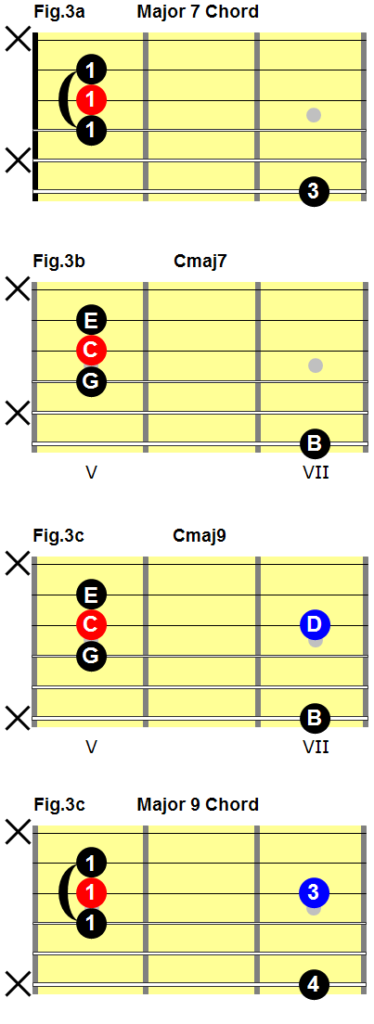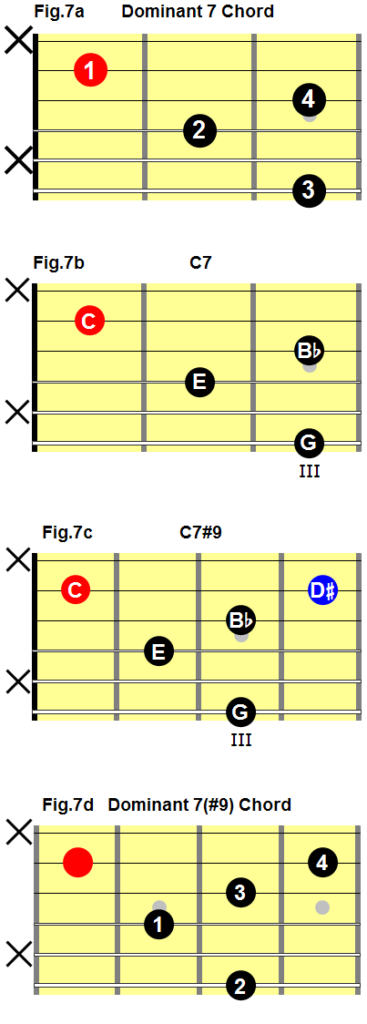Throughout this series, I have provided common fingerings for the chords covered and I have recommended that you learn as many different voicings as possible for each of the chords.
One way to learn additional voicings is to create them yourself from basic chord voicings you already know.
This post will provide instruction on how to alter basic seventh chord voicings on a guitar to create voicings for:
- Sixth chords.
- Ninth chords.
- Altered ninth chords.
Essential and Non-essential Notes
Not all of the notes in a chord’s formula have to be present in any particular voicing of the chord. Some notes are essential and should be included and other notes are less important and can be omitted.
The important notes that should always be included in a chord voicing are:
- The chord’s third and seventh notes (except in suspended chords and some extended chords).
- An extended chord’s highest extension note.
- An altered chord’s altered note or notes.
Root notes, fifths and other extension notes are less important and can be omitted.
Creating Chord Voicings
The process of creating a chord voicing from a seventh chord voicing you already know involves taking a note from the seventh chord voicing and changing it to a note that is essential to be included in the new chord.
Standard rules govern which note in the seventh chord should be altered to create the new chord.
Sixth Chords
Rule: To create a sixth chord voicing, change the seventh scale degree in the seventh chord voicing to the sixth scale degree.
Creating Major Sixth Chords: Theory
The chord formula for a major seventh chord is 1, 3, 5, 7.
The chord formula for a major sixth chord is 1, 3, 5, 6.
The only difference between the two chords is that the major seventh chord contains the seventh degree of the major scale with the same root note and the major sixth chord contains the sixth scale degree, instead of the seventh.
To create a major sixth chord voicing from a major seventh chord voicing:
- Locate the note in the major seventh chord that is the scale’s seventh degree.
- Change that note to the note that is the scale’s sixth degree.
Creating Major Sixth Chords: On a Guitar
To create a C6 chord voicing from a Cmaj7 chord voicing:
- Locate the note in the Cmaj7 chord that is the scale’s seventh degree (B).
- Change that note to the note that is the scale’s sixth degree (A).
A common fingering for a major seventh chord is shown in fig.1a.
To play a Cmaj7 chord place your first finger on the C on the sixth string, eighth fret (fig.1b).
To create a C6 chord:
- Locate the B in the Cmaj7 chord (highlighted in blue).
- Change the B to an A (fig.1c, highlighted in blue).
You now have a movable major sixth chord fingering (fig.1d).
Fig.1

Creating Minor Sixth Chords: Theory
The chord formula for a minor seventh chord is 1, b3, 5, b7.
The chord formula for a minor sixth chord is 1, b3, 5, 6.
The only difference between the two chords is that the minor seventh chord contains the flatted seventh degree of the major scale with the same root note and the minor sixth chord contains the sixth scale degree, instead of the flatted seventh.
To create a minor sixth chord voicing from a minor seventh chord voicing:
- Locate the note in the minor seventh chord that is the scale’s flatted seventh degree.
- Change that note to the note that is the scale’s sixth degree.
Creating Minor Sixth Chords: On a Guitar
To create a Cm6 chord voicing from a Cm7 chord voicing:
- Locate the note in the Cm7 chord that is the scale’s flatted seventh degree (Bb).
- Change that note to the note that is the scale’s sixth degree (A).
A common fingering for a minor seventh chord is shown in fig.2a.
To play a Cm7 chord, place your second finger on the C on the sixth string, eighth fret (fig.2b).
To create a Cm6 chord:
- Locate the Bb in the Cm7 chord (highlighted in blue).
- Change the Bb to an A (fig.2c).
You now have a movable minor sixth chord fingering (fig.2d).
Fig.2

Ninth and Altered Ninth Chords
Rule: To create a ninth (or altered ninth) chord voicing, change the root note in a seventh chord voicing to the ninth (or altered ninth) scale degree.
Creating Major NInth Chords: Theory
The chord formula for a major seventh chord is 1, 3, 5, 7.
The chord formula for a major ninth chord is 1, 3, 5, 7, 9.
The only difference between the two chords is that the major ninth chord contains an additional note, the ninth scale degree.
To create a major ninth chord voicing from a major seventh chord voicing:
- Locate the note in the major seventh chord that is the scale’s root note.
- Change that note to the note that is the scale’s ninth degree.
Creating Major Ninth Chords: On a Guitar
To create a Cmaj9 chord voicing from a Cmaj7 chord voicing:
- Locate the note in the Cmaj7 chord that is the chord’s root note (C).
- Change that note to the note that is the scale’s ninth degree (D).
A common fingering for a major seventh chord is shown in fig.3a.
To play a Cmaj7 chord, place the barre on the fifth fret (fig.3b).
To create a Cmaj9 chord:
- Locate the C in the Cmaj7 chord (highlighted in red).
- Change the C to a D (fig.3c, highlighted in blue).
The root note (C) remains in the diagram as a point of reference but obviously will not ring out with the D fretted.
You now have a movable major ninth chord fingering, without a ringing root note. (fig.3d).
Fig.3

Creating Minor Ninth Chords: Theory
The chord formula for a minor seventh chord is 1, b3, 5, b7.
The chord formula for a minor ninth chord is 1, b3, 5, b7, 9.
The only difference between the two chords is that the minor ninth chord contains an additional note, the ninth scale degree.
To create a major ninth chord voicing from a major seventh chord voicing:
- Locate the note in the minor seventh chord that is the scale’s root note.
- Change that note to the note that is the scale’s ninth degree.
Creating Minor Ninth Chords: On a Guitar
To create a Cm9 chord voicing from a Cm7 chord voicing:
- Locate the note in the Cm7 chord that is the chord’s root note (C).
- Change that note to the note that is the scale’s ninth degree (D).
A common fingering for a minor seventh chord is shown in fig.4a.
To play a Cm7 chord, place your first finger on the C on the fourth string, 10th fret (fig.4b).
To create a Cm9 chord:
- Locate the C in the Cm7 chord (highlighted in red).
- Change the C to a D (fig.4c, highlighted in blue).
The location of the root note (C) remains in the diagram as a point of reference but is not fretted or ringing.
You now have a movable minor ninth chord fingering, without a fretted or ringing root note (fig.4d).
Fig.4

Creating Dominant Ninth Chords: Theory
The chord formula for a dominant seventh chord is 1, 3, 5, b7.
The chord formula for a dominant ninth chord is 1, 3, 5, b7, 9.
The only difference between the two chords is that the dominant ninth chord contains an additional note, the ninth scale degree.
To create a dominant ninth chord voicing from a dominant seventh chord voicing:
- Locate the note in the dominant seventh chord that is the scale’s root note.
- Change that note to the note that is the scale’s ninth degree.
Creating Dominant Ninth Chords: On a Guitar
To create a C9 chord voicing from a C7 chord voicing:
- Locate the note in the C7 chord that is the chord’s root note (C).
- Change that note to the note that is the scale’s ninth degree (D).
A common fingering for a dominant seventh chord is shown in fig.5a.
To play a Cm7 chord, place your first finger on the C on the second string, first fret (fig.5a).
To create a Cm9 chord:
- Locate the C in the C7 chord (highlighted in red).
- Change the C to a D (fig.5c, highlighted in blue).
The location of the root note (C) remains in the diagram as a point of reference but is not fretted and will not ring out.
You now have a movable minor ninth chord fingering, without a fretted or ringing root note. (fig.5d).
Fig.5

Creating Dominant Seventh, Flat Nine Chords: Theory
The chord formula for a dominant seventh chord is 1, 3, 5, b7.
The chord formula for a dominant seventh, flat nine chord is 1, 3, 5, b7, b9.
The only difference between the two chords is that the dominant seventh, flat nine chord contains an additional note, the flatted ninth scale degree.
To create a dominant seventh, flat nine chord voicing from a dominant seventh chord voicing:
- Locate the note in the dominant seventh chord that is the scale’s root note.
- Change that note to the note that is the scale’s flatted ninth degree.
Creating Dominant Seventh, Flat Nine Chords: On a Guitar
To create a C7(b9) chord voicing from a C7 chord voicing:
- Locate the note in the C7 chord that is the chord’s root note (C).
- Change that note to the note that is the scale’s flatted ninth degree (Db).
A common fingering for a dominant seventh chord is shown in fig.6a.
To play a C7 chord, place your first finger on the C on the second string, first fret (fig.6b).
To create a C7(b9) chord:
- Locate the C in the C7 chord, highlighted in red.
- Change the C to a Db (fig.6c, highlighted in blue).
The location of the root note (C) remains in the diagram as a point of reference but is not fretted and will not ring out.
You now have a movable dominant seventh, flat nine chord fingering, without a fretted or ringing root note. (fig.6d).
Fig.6

Creating Dominant Seventh, Sharp Nine Chords: Theory
The chord formula for a dominant seventh chord is 1, 3, 5, b7.
The chord formula for a dominant seventh, sharp nine chord is 1, 3, 5, b7, #9.
The only difference between the two chords is that the dominant ninth chord contains an additional note, the sharped ninth scale degree.
To create a dominant seventh, sharp nine chord voicing from a dominant seventh chord voicing:
- Locate the note in the dominant seventh chord that is the scale’s root note.
- Change that note to the note that is the scale’s sharped ninth degree.
Creating Dominant Seventh, Sharp Nine Chords: On a Guitar
To create a C7(#9) chord voicing from a C7 chord voicing:
- Locate the note in the C7 chord that is the chord’s root note (C).
- Change that note to the note that is the scale’s sharped ninth degree (D#).
A common fingering for a dominant seventh chord is shown in fig.7a.
To play a C7 chord, place your first finger on the C on the second string, first fret (fig.7b).
To Create a C7(#9) chord:
- Locate the C in the C7 chord (highlighted in red).
- Change the C to a D# (fig.7c, highlighted in blue).
The location of the root note (C) remains in the diagram as a point of reference but is not fretted and will not ring out.
You now have a movable dominant seventh, sharp nine chord fingering, without a fretted or ringing root note. (fig.7d).
Fig.7

Related Posts
Related posts include:
